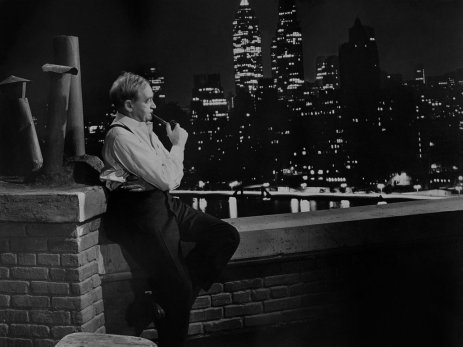
‘Jean Dexter is dead. The answer must be somewhere down there.’, says our narrator, the film’s producer, Mark Hellinger. And he’s right. Down there, on the all too familiar streets of New York, lies the answer to Jean Dexter’s murder. And the robberies. And whether or not Frank Niles (Howard Duff) knows anything about it. And… well, you know how it goes in a film noir. Except that I’m not too sure about The Naked City (dir. Jules Dassin) being classified as noir. Sure, the title sounds like a noir. But to me, it’s more of a documentary-style crime drama than a noir. Anyway, that’s not really important. The Naked City is too significant to be boiled down to a genre. The Naked City doesn’t have a genre. It created one: the New York City genre.
As our narrator takes us through the everyday lives of our New Yorkers, complete with iconic landmarks and equally iconic sounds, little do we know that Jean Dexter is being murdered. That is, until it is brutally shown to us, in the midst of that perfectly nice montage of New York. After that, the investigation, led by Dan Muldoon (brilliantly played by Barry Fitzgerald) and Jimmy Halloran (Don Taylor) begins and we’re taken on a journey through crime and New York.
The Naked City is a fantastic film in itself but what really astonishes me about it, is how immensely influential it clearly is. When I was watching it, there were so many scenes and elements that reminded me of later films, such as The Big Heat (1953), The French Connection (1971), Pulp Fiction (1994), L.A. Confidential (1997), not to mention practically every Woody Allen film, including his most famous shot (from Manhattan, 1979), which you will immediately recognize as you’re watching this. But the thing is, it hardly gets any credit, in comparison with the ‘giants’ of the influential film realm. This is probably the most influential film that gets mentioned the least.
Part of its influence is, of course, the New York City motif. It has been used in countless films, but did it start here? Sure, there were movies prior to this that were set in New York and made good use of it – Street Scene (1931) comes to mind – but The Naked City delivers what it promises: New York City at its most vulnerable and…. naked. New York is the main character in The Naked City. So much so, that it won the Oscar for Best Cinematography (William H. Daniels), as well as Best Editing (Paul Weatherwax). Malvin Wald’s story was also nominated, losing out to The Search (1948). And if you’re wondering about Barry Fitzgerald failing to get a nomination… yeah, I’d like to know the answer to that as well.
There are eight million reviews about The Naked City. This has been one of them.

I love your review!!! Very important question about the Noir and Documentary genres concern where Naked City belongs..but most of all that voice over here is so moving and adds to power of those real NYC locations…looking forward to further discussions about other Classic movies .
LikeLiked by 2 people
Thank you so much! 😀
LikeLiked by 2 people
The visual style of The Naked City was inspired by New York photographer Weegee, who published a book of photographs of New York life entitled Naked City (1945). Weegee was hired as a visual consultant on the film, and is credited with helping to craft its imagery.
LikeLiked by 2 people
Indeed. It’s stunning.
LikeLiked by 1 person
Sounds intriguing!!!
LikeLiked by 1 person
It’s awesome!!
LikeLiked by 1 person
What a terrific appreciation of THE NAKED CITY and of NYC as genre. I agree!
LikeLiked by 1 person
Thank you!! 😀
LikeLike
Thanks Carol for another great review. Love New York City films. Also reminds me of that classic New York City director – Sidney Lumet. .
LikeLiked by 1 person
Oh yes! One of my favorites as well.
LikeLiked by 1 person
Haha! I love how you concluded your post with “There are 8 million reviews…” Very clever.
You’re right – this film is hugely influential but doesn’t seem to attract the same attention as other films of the era. It’s a real shame because, as you pointed out, it’s a really, really good film. You did a good thing by featuring it on your fab site. 🙂
LikeLiked by 1 person
Thank you so much!!! 😀
LikeLike
Excellent comment with regard to the film’s attention/reception level.
It’s not uncommon… with the police/sleuth procedural segue intervals to ambivalent characters and existential scenario. The continuity rarely connects, hence, terms like docu-drama.
The Lineup experienced a similar fate. As well as, T-Men, Call Northside 777 or The Street With No Name.
The voiceover narrator is a key element to this transitional confusion too. Like subliminally seducing the viewer with story points that suggest clarity and understanding rather then the reality that it’s like watching two disparate films in one.
LikeLiked by 2 people
That’s a very good point about the narration! Wonderful insight.
Thank you Brian! 😀
LikeLike
Awesome review Carol and a very thoughtful one. When you mention “New-York City genre”, it immediately made me think of Sweet Smell of Success 🙂
LikeLiked by 1 person
OH yes! One of my very favorites!
Thank you!! 😀
LikeLiked by 1 person
Pingback: ONE MOVIE, THREE QUOTES: The Naked City (1948) – The Old Hollywood Garden